#baekje
Photo

Ancient Korean & Japanese Relations
Ancient East Asia was dominated by the three states known today as China, Japan, and Korea. These kingdoms traded raw materials and high-quality manufactured goods, exchanged cultural ideas and practices, and fought each other in equal measure throughout the centuries. The complex chain of successive kingdoms in all three states has created a rich web of events that historians have sometimes found difficult to disentangle; a situation not helped by modern nationalist claims and ideals superimposed on antiquity from all three parties. As the historian Kim Won-Yong put it, "Korea acted as a cultural bridge between China and Japan" (Portal, 20). Historians continue to discuss whether that bridge was one-way or two-way traffic and, if the former, which direction, but suffice to say that there was such a bridge, and its consequences in art, politics, and history in both countries still resonate today.
First Trade Relations
It is likely that there was contact between the Japanese islands and the Korean peninsula in the Neolithic period (6,000-1,000 BCE), especially considering the lower sea-level at that time and so closer geographical proximity of the two land masses. However, the first recorded ties between Japan, specifically the island of Kyushu, which the Koreans called Wae (and the Chinese Wa), occurred in the period known as the Proto-Three Kingdoms period between the 1st and 3rd centuries CE. The fragmented territories in the south of the peninsula were not yet centralised states, but international relations were developed by the Chinese commanderies which occupied the north of Korea at this time, especially Lelang. Envoys and tribute were sent by the Wa, now a confederation of small states in southern and western Japan, the most important of which was Yamato. These missions are recorded in 57, 107, 238, and 248 CE.
Continue reading...
33 notes
·
View notes
Photo
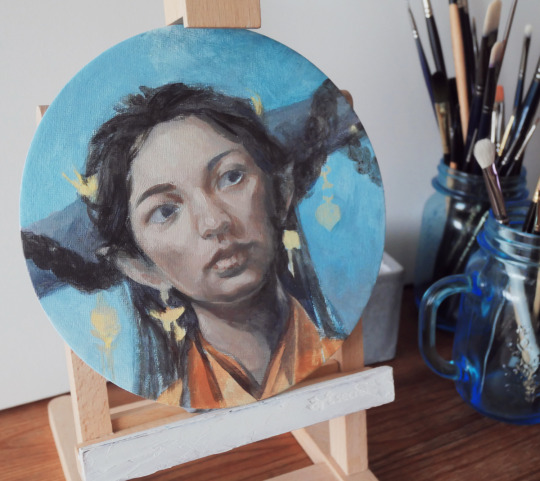

I like this painterly stage - everything’s still a bit rough, but also expressive.
Historical Korean setting inspired Tiefling. Character art commissions for April/May are open
#Tiefling#traditional art#tiefling art#tiefling character#character art#portrait painting#character design#character concept#Korean history#Historical Fantasy#historical clothing#baekje#commissions open#art commissions#dnd art#dnd character#dnd 5e#dnd tiefling
27 notes
·
View notes
Text

They forgot one thing:
They're fighting monsters from a star, not japanese warriors.
#omniscient reader's viewpoint#omniscient reader#orv#omniscient reader webtoon#webtoon#min jiwon#ruler of beauty#silla#cha sakyung#maitreya ruler#baekje#kim dokja#kdj#sing song#sing shong#episode 119
2 notes
·
View notes
Photo
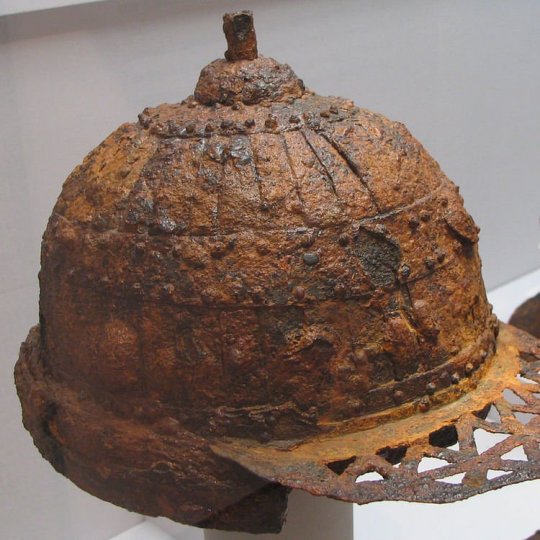
Gaya
Gaya (alias Kaya, Garak) était une confédération qui régnait sur le centre et le sud de la Corée pendant la période des Trois Royaumes, du 1er au 6e siècle de notre ère. La péninsule était dominée par ses royaumes voisins plus puissants, à savoir Goguryeo (Koguryo), Baekje (Paekche) et Silla, mais Gaya, souvent l'entité oubliée de cette période, était néanmoins riche en minerai de fer et ses artisans devinrent très compétents dans la fabrication d'objets en fer tels que les armures et les armes. Le haut niveau de culture atteint par les États de Gaya allait influencer le Japon, leur principal partenaire commercial. La confédération prit définitivement fin lorsqu'elle fut entièrement conquise par le royaume de Silla en 562.
Lire la suite...
3 notes
·
View notes
Text
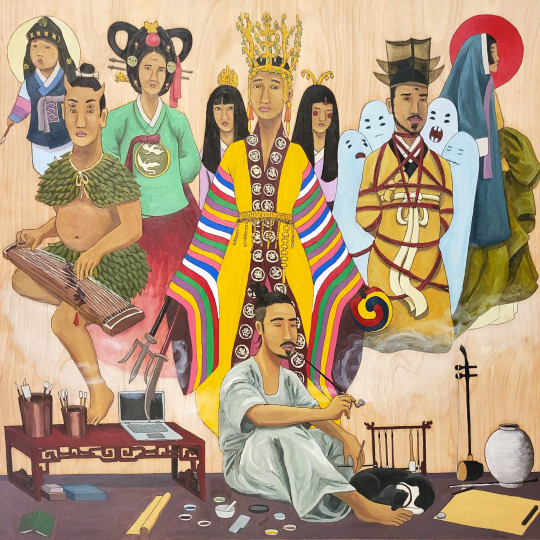
Gyopo Has a Smoke Before Painting Folk
Self-portrait with 19th-century Joseon painter's tools and an assortment of motherland artifacts, attire, and anachronisms
1 note
·
View note
Photo

Yeri "REDVelvet Active for a long time but a complete rookie as an actor"
Source: k-star-holic.blogspot.com
0 notes
Photo
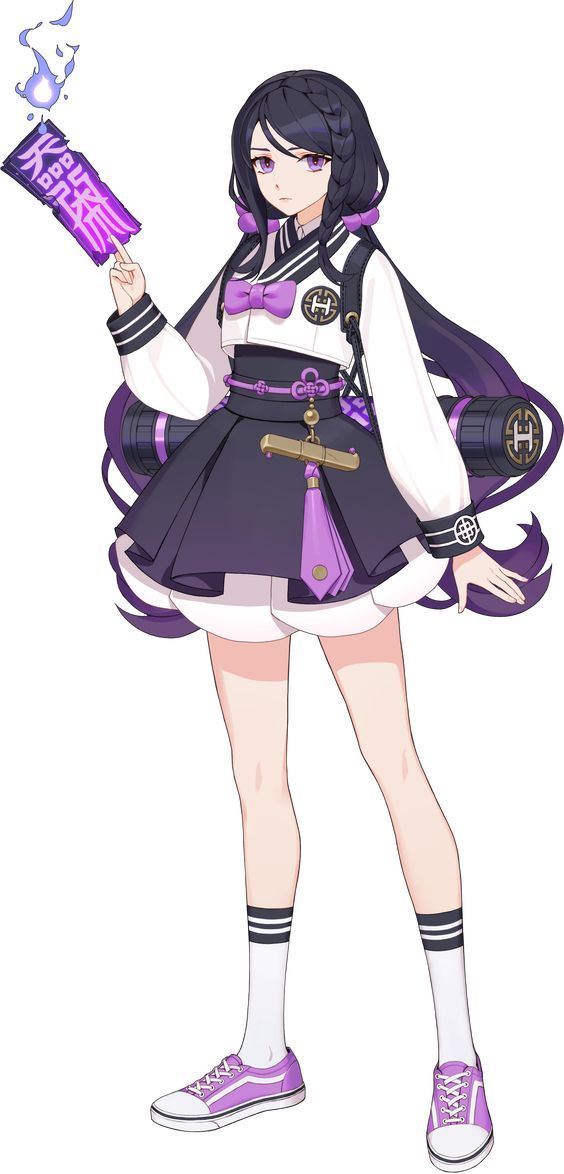
Eternal Return Advent Calendar Day 12 Lee Hyejin (Baekje)
Lavender Shampoo and Conditioner
Alcohol Purple Markers
Purple Vans
Purple Travel Bag
Christmas Purple Neon
Purple Crystal Earrings
Korean Chocolate
LG Hair Straightener
Purple Christmas Pillow
Purple Tight
1 note
·
View note
Text
youtube
Ancient Korean Architecture in Context, September 8, 2022
This webinar, inspired by the current exhibition Once Upon a Roof: Vanished Korean Architecture, examines recent research findings on ancient Korean architecture and ceramic roof tiles created more than one thousand years ago during the Three Kingdoms and Unified Silla kingdoms. Although no buildings from these periods survive, archaeological surveys reveal the advent of distinct regional styles on the peninsula that contributed to the complex cultural exchanges taking place in East Asia from the fifth through the ninth centuries. The four featured scholars from Korea and the United States will place Korea's earliest wooden architectural traditions in a broader East Asian context. Special emphasis is placed on roof tiles— the subject of the current exhibition—and two speakers will address the original design and fabrication of a special type of ornamented roof tile, called chimi in Korean, that crowned both ends of the main roof ridge of prominent buildings. Using examples excavated at important historical sites, specialists will address their discovery and reconstruction.
Speakers include:
Lee Byongho, Gongju National University of Education, Gongju Jeong Hyun, National Museum of Korea, Seoul Hwang Hyun Sung, National Museum of Korea, Seoul
Smithsonian's National Museum of Asian Art
#Once Upon a Roof: Vanished Korean Architecture#exhibition#art#art history#Korean#National Museum of Korea#japanese#Buddhism#National Museum of Asian Art#archaeology#architecture#history#Smithsonian#Asukadera#Baekje#Goguryeo#cultural amalgam#Silla#Unified Silla#Three Kingdoms of Korea#design#Asuka period#Nara period#conservation#reconstruction#pattern#ceramics
1 note
·
View note
Note
When do u think the modern personification of Korea was born? Cause there is the kingdom of Goguryeo which place Korea at like 4000(but like would it be like a china situation where it’s the same personification who’s just stupidly old or like Greece and Egypt where they had an ancient version) there’s also the three kingdoms period which started about 2000 years ago. Or there’s even the more modern eras like Joseon. I’m just curious how old u see the current personification as.
*Gojoseon I accidentally typed the wrong G kingdom. Goguryeo was later on. Sorry for any confusion
thanks for the question! this is my personal take on it: yong-soo is at least 2000 years old; he thus dates back to the three kingdoms period rather than to gojoseon. i do think there's always some wiggle room with the age of a personification and how we interpret history so i can see other variations; my main hard no is making him too young (such as born after the 1950 korean war...please no).
contemporarily, yong-soo represents south korea, but in the beginning, i see him as the old korean kingdom of silla. nations don't suddenly spring into existence overnight, so while silla was was officially founded in 57 BCE, he's probably older than that. that's just the latest date i see him being around by. yong soo, imo, also has/had at least two brothers: goguryeo (who later represents north korea after wwii) and baekje, who was kiku's close ally—as per how, in real history, the kingdom of baekje and yamato japan had quite an important alliance. baekje dies by a combination of yong-soo and yao's actions after the baekje-tang war—as per how baekje got annexed into the kingdom of silla, and china crushed the japanese forces attempting to support baekje restorationists at the battle of baekgang. i don't think yong-soo necessarily wanted his brother to die, but it was a power struggle, and those have consequences (as tang dynasty yao would probably say coolly, while seated atop his war horse...😔)—nations mirror humans, and how often have royal houses across different cultures warred against family members throughout human history? so, it's kind of sombre but there were once three brothers.
overall, i see yong-soo as an old nation who's lived many lives before his present incarnation as the republic of korea (and in the east asian cosmology; reincarnation is quite a familiar concept for us). i see him being older than kiku, and he's the one who taught kiku advanced shipbuilding and navigation, as a reflection of how mariners/shipbuilders from silla influenced japan. this is naturally very ironic from the meiji era onwards, particularly when korea comes under japanese colonial rule, and kiku refashions himself as a 'modern' naval power. so, rather than the canon dynamic that seems to posit a rather youthful yong-soo vs. old man china and japan...imo it's really Old Men Wrestling with the Confucian Hierarchy All the Way Down (even if Yong-soo's skincare regimen means he looks good and he is skilled at putting on a friendly and youngish persona if need be). one implication that's important to me about yong-soo's age is exploring how he and kiku (and also yao) have a very old relationship that runs deep due to all that history and cultural exchange, but it is naturally, far from easy.
29 notes
·
View notes
Note
Baekje finding jp: what's with this sassy...lost child

(not my actual Baekje design i scribbled this quickly and i dont have a design for them yet) Although they allied later I don’t think Baekje’s first impression of this little brat across the water was very good
9 notes
·
View notes
Photo

The Horse-rider Theory in Ancient Japan
The 'horse-rider theory' is a controversial proposal that Japan was conquered around the 4th or 5th century CE by a culture from northern Asia to whom the horse was especially important. Although archaeological evidence and genetics point to a close relationship between Japan and East Asia, especially Korea, during that period, the idea that a full military takeover ever occurred is deemed unlikely by most historians. The exact relations between the young states of the region remain unclear, and the issue is further clouded by nationalist agendas and a persistent projection of modern concepts of statehood and nationality on geographical areas which at that time would not have existed.
Continue reading...
44 notes
·
View notes
Text


Yamato Period - (250–710) (or Asuka Period from 592 to 645) - At the era of Prince Shōtoku in the early 7th century, a new constitution was prescribed for Japan based on the Chinese model. After the fall of Baekje (660 AD), the Yamato government sent envoys directly to the Chinese court, from which they obtained a great wealth of philosophical and social structure. In addition to ethics and government, they also adopted the Chinese calendar and many of its religious practices, including Confucianism and Taoism.
Kumashu - Kuma (meaning "bear") and So (written with the character for "attack" or "layer on").
& Hayato - (隼人), which is Japanese for "falcon-people"
Emishi - Shrimp Barbarian (In later records, the kanji spelling changed to 蝦夷, composed of the characters for "shrimp" and "barbarian". The use of the "shrimp" spelling is thought to refer to facial hair, like the long whiskers of a shrimp, but this is not certain.)
I did some more research on the kingdoms of Korea and based on the history Silla is the kingdom that will take over Baekje and that took over already Gaya, and later will attack Goguryeo too!
The Goguryeo–Tang War will be from 645 to 668 and there Goguryeo will die. (The war marked the end of the Three Kingdoms of Korea period)
🡆 Important- I did some confusion in a previous post with them , Ill try to be more careful!
Tang Dynasty -(618 to 907 AD) It is traditionally considered the greatest age for Chinese poetry! (Three Hundred Tang Poems), Many famous painters (like Zhou Fang) were active, while Chinese court music flourished with instruments such as the popular Pipa!
(I may have done errors , if anyone has more information or adjustements you're more than welcome to help!)
#countryhumans tang dynasty#countryhumans yamato period#countryhumans kumashu#countryhumans emishi#countryhumans silla#countryhumans baekje#countryhumans goguryeo
33 notes
·
View notes
Photo
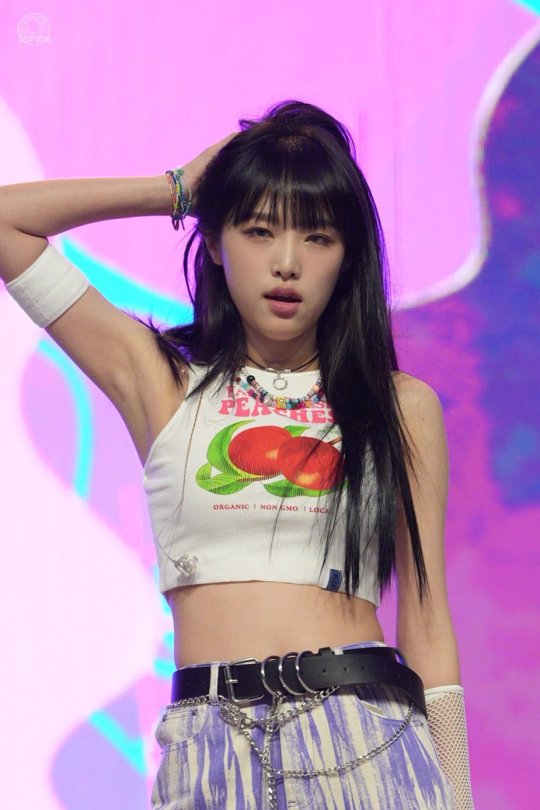
© 𝕊𝕙𝕚𝕣𝕠𝕙𝕒° | do not edit and/or crop logo
4 notes
·
View notes
Text
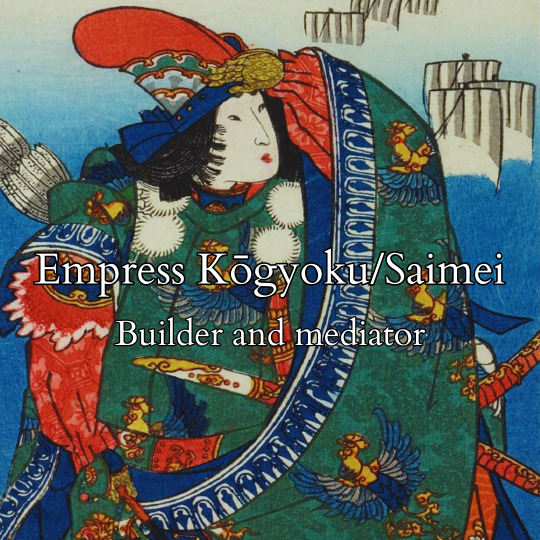
Kōgyoku/Saimei (594-661) was Japan’s second empress regnant according to the traditional chronology, with the notable particularity of having reigned twice.
Her first reign ends in blood
Though stable during Empress Suiko’s reign, the court reverted to a state of unrest after her death. Emperor Jomei, died without designating a successor. To put an end to the power struggles, his widow, Princess Takara, was chosen in 642. She was 49 years old and would thus be known as Kōgyoku Tennō.
As the region was hit by a severe drought, Kōgyoku prayed and the rain fell. She thus won her subject's respect.
In 645, her son, Prince Naka no Ōe , killed minister Soga no Iruka in front of her in the throne room. Kōgyoku knew nothing of the plot. As she confronted him, her son explained that Iruka was guilty of treason.
The empress left the scene and abdicated two days later in favor of her brother Kōtoku, with Naka no Ōe becoming heir apparent.
In 654, Kōtoku died of an illness and his sister took the throne again as the 37th Tennō, called Saimei.
A mediator and a builder
Saimei fostered international relations by sending envoys to Tang China and opening exchanges with the three kingdoms of Korea. She undertook many building projects to show the prosperity of her realm and receive foreign envoys.
Many of those buildings were made of stone. However, not all her projects were met with approval. Such was the case of a facility with an imposing stone wall and necessitating the manual digging of a canal. It nonetheless seems that this canal had two purposes: irrigate the fields and form a moat that would deter enemy invasions.
At the end of her life, Saimei planned a military to help the kingdom Korean kingdom of Baekje against Silla and China. She was at Tsukushi, readying her troops, when she died at age 68. Before passing away, she told her son Naka not to waste a great amount of labor in building her tomb.
The navy suffered a terrible defeat after her passing. Her son Naka no Ōe would later rule as emperor Tenji.
A loving grandmother
Saimei played an important role in politics by achieving peace between rival factions. She also raised her granddaughter Jitō, who would become a powerful empress in her own right. Extremely saddened by the death of her grandson prince Takeru in 658, she asked to be buried beside him and wrote two poems:
Above the hill
At Imaki
If even a cloud
Would only appear,
Then why should I grieve?
I did not think of him
As being a mere child, young
Like the young grass
By the river bank, where they track
The wounded deer.
Like the foaming waters
Of the Asuka river,
Moving on ceaselessly:
Without pause
Does my mind dwell on him
And:
Though I cross the mountains
And sail over the seas,
I shall not forget
The happy
Times in Imaki.
The salt current
At the river mouth
Flows back into the sea:
With darkness at my back,
Must I go, leaving him behind?
Must I go,
Leaving behind
My beloved young child?
Feel free to check out my Ko-Fi if you want to support me!
Further reading:
Toshio Akima, "The Songs of the Dead: Poetry, Drama, and Ancient Death Rituals of Japan"
"The story of Empress Saimei"
Aoki Michiko Y., “Jitō Tennō, the female sovereign”, in: Mulhern Chieko Irie (ed.), Heroic with grace legendary women of Japan
#kogyoku#saimei#japan#japanese history#japanese empresses#7th century#history#women in history#women's history#historyedit#poets#poetry#historyblr#queens#leaders#powerful women
97 notes
·
View notes
Text
Shikigami and onmyōdō through history: truth, fiction and everything in between
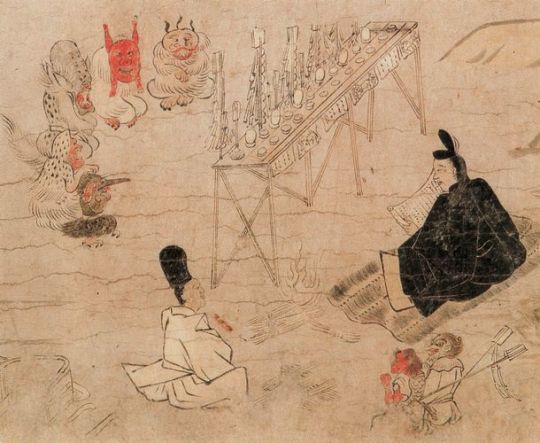
Abe no Seimei exorcising disease spirits (疫病神, yakubyōgami), as depicted in the Fudō Riyaku Engi Emaki. Two creatures who might be shikigami are visible in the bottom right corner (wikimedia commons; identification following Bernard Faure’s Rage and Ravage, pp. 57-58)
In popular culture, shikigami are basically synonymous with onmyōdō. Was this always the case, though? And what is a shikigami, anyway? These questions are surprisingly difficult to answer. I’ve been meaning to attempt to do so for a longer while, but other projects kept getting in the way. Under the cut, you will finally be able to learn all about this matter.
This isn’t just a shikigami article, though. Since historical context is a must, I also provide a brief history of onmyōdō and some of its luminaries. You will also learn if there were female onmyōji, when stars and time periods turn into deities, what onmyōdō has to do with a tale in which Zhong Kui became a king of a certain city in India - and more!
The early days of onmyōdō
In order to at least attempt to explain what the term shikigami might have originally entailed, I first need to briefly summarize the history of onmyōdō (陰陽道). This term can be translated as “way of yin and yang”, and at the core it was a Japanese adaptation of the concepts of, well, yin and yang, as well as the five elements. They reached Japan through Daoist and Buddhist sources. Daoism itself never really became a distinct religion in Japan, but onmyōdō is arguably among the most widespread adaptations of its principles in Japanese context.

Kibi no Makibi, as depicted by Yoshitoshi Tsukioka (wikimedia commons)
It’s not possible to speak of a singular founder of onmyōdō comparable to the patriarchs of Buddhist schools. Bernard Faure notes that in legends the role is sometimes assigned to Kibi no Makibi, an eighth century official who spent around 20 years in China. While he did bring many astronomical treatises with him when he returned, this is ultimately just a legend which developed long after he passed away.
In reality onmyōdō developed gradually starting with the sixth century, when Chinese methods of divination and treatises dealing with these topics first reached Japan. Early on Buddhist monks from the Korean kingdom of Baekje were the main sources of this knowledge. We know for example that the Soga clan employed such a specialist, a certain Gwalleuk (観勒; alternatively known under the Japanese reading of his name, Kanroku).
Obviously, divination was viewed as a very serious affair, so the imperial court aimed to regulate the continental techniques in some way. This was accomplished by emperor Tenmu with the formation of the onmyōryō (陰陽寮), “bureau of yin and yang” as a part of the ritsuryō system of governance. Much like in China, the need to control divination was driven by the fears that otherwise it would be used to legitimize courtly intrigues against the emperor, rebellions and other disturbances.
Officials taught and employed by onmyōryō were referred to as onmyōji (陰陽師). This term can be literally translated as “yin-yang master”. In the Nara period, they were understood essentially as a class of public servants. Their position didn’t substantially differ from that of other specialists from the onmyōryō: calendar makers, officials responsible for proper measurement of time and astrologers. The topics they dealt with evidently weren’t well known among commoners, and they were simply typical members of the literate administrative elite of their times.
Onmyōdō in the Heian period: magic, charisma and nobility
The role of onmyōji changed in the Heian period. They retained the position of official bureaucratic diviners in employ of the court, but they also acquired new duties. The distinction between them and other onmyōryō officials became blurred. Additionally their activity extended to what was collectively referred to as jujutsu (呪術), something like “magic” though this does not fully reflect the nuances of this term. They presided over rainmaking rituals, purification ceremonies, so-called “earth quelling”, and establishing complex networks of temporal and directional taboos.

A Muromachi period depiction of Abe no Seimei (wikimedia commons)
The most famous historical onmyōji like Kamo no Yasunori and his student Abe no Seimei were active at a time when this version of onmyōdō was a fully formed - though obviously still evolving - set of practices and beliefs. In a way they represented a new approach, though - one in which personal charisma seemed to matter just as much, if not more, than official position. This change was recognized as a breakthrough by at least some of their contemporaries. For example, according to the diary of Minamoto no Tsuneyori, the Sakeiki (左經記), “in Japan, the foundations of onmyōdō were laid by Yasunori”.
The changes in part reflected the fact that onmyōji started to be privately contracted for various reasons by aristocrats, in addition to serving the state. Shin’ichi Shigeta notes that it essentially turned them from civil servants into tradespeople. However, he stresses they cannot be considered clergymen: their position was more comparable to that of physicians, and there is no indication they viewed their activities as a distinct religion. Indeed, we know of multiple Heian onmyōji, like Koremune no Fumitaka or Kamo no Ieyoshi, who by their own admission were devout Buddhists who just happened to work as professional diviners.
Shin’ichi Shigeta notes is evidence that in addition to the official, state-sanctioned onmyōji, “unlicensed” onmyōji who acted and dressed like Buddhist clergy, hōshi onmyōji (法師陰陽師) existed. The best known example is Ashiya Dōman, a mainstay of Seimei legends, but others are mentioned in diaries, including the famous Pillow Book. It seems nobles particularly commonly employed them to curse rivals. This was a sphere official onmyōji abstained from due to legal regulations. Curses were effectively considered crimes, and government officials only performed apotropaic rituals meant to protect from them.
The Heian period version of onmyōdō captivated the imagination of writers and artists, and its slightly exaggerated version present in classic literature like Konjaku Monogatari is essentially what modern portrayals in fiction tend to go back to.
Medieval onmyōdō: from abstract concepts to deities

Gozu Tennō (wikimedia commons)
Further important developments occurred between the twelfth and fourteenth centuries. This period was the beginning of the Japanese “middle ages” which lasted all the way up to the establishment of the Tokugawa shogunate. The focus in onmyōdō in part shifted towards new, or at least reinvented, deities, such as calendarical spirits like Daishōgun (大将軍) and Ten’ichijin (天一神), personifications of astral bodies and concepts already crucial in earlier ceremonies. There was also an increased interest in Chinese cosmological figures like Pangu, reimagined in Japan as “king Banko”. However, the most famous example is arguably Gozu Tennō, who you might remember from my Susanoo article.
The changes in medieval onmyōdō can be described as a process of convergence with esoteric Buddhism. The points of connection were rituals focused on astral and underworld deities, such as Taizan Fukun or Shimei (Chinese Siming). Parallels can be drawn between this phenomenon and the intersection between esoteric Buddhism and some Daoist schools in Tang China. Early signs of the development of a direct connection between onmyōdō and Buddhism can already be found in sources from the Heian period, for example Kamo no Yasunori remarked that he and other onmyōji depend on the same sources to gain proper understanding of ceremonies focused on the Big Dipper as Shingon monks do.
Much of the information pertaining to the medieval form of onmyōdō is preserved in Hoki Naiden (ほき内伝; “Inner Tradition of the Square and the Round Offering Vessels”), a text which is part divination manual and part a collection of myths. According to tradition it was compiled by Abe no Seimei, though researchers generally date it to the fourteenth century. For what it’s worth, it does seem likely its author was a descendant of Seimei, though.
Outside of specialized scholarship Hoki Naiden is fairly obscure today, but it’s worth noting that it was a major part of the popular perception of onmyōdō in the Edo period. A novel whose influence is still visible in the modern image of Seimei, Abe no Seimei Monogatari (安部晴明物語), essentially revolves around it, for instance.
Onmyōdō in the Edo period: occupational licensing
Novels aside, the first post-medieval major turning point for the history of onmyōdō was the recognition of the Tsuchimikado family as its official overseers in 1683. They were by no means new to the scene - onmyōji from this family already served the Ashikaga shoguns over 250 years earlier. On top of that, they were descendants of the earlier Abe family, the onmyōji par excellence. The change was not quite the Tsuchimikado’s rise, but rather the fact the government entrusted them with essentially regulating occupational licensing for all onmyōji, even those who in earlier periods existed outside of official administration.
As a result of the new policies, various freelance practitioners could, at least in theory, obtain a permit to perform the duties of an onmyōji. However, as the influence of the Tsuchimikado expanded, they also sought to oblige various specialists who would not be considered onmyōji otherwise to purchase licenses from them. Their aim was to essentially bring all forms of divination under their control. This extended to clergy like Buddhist monks, shugenja and shrine priests on one hand, and to various performers like members of kagura troupes on the other.
Makoto Hayashi points out that while throughout history onmyōji has conventionally been considered a male occupation, it was possible for women to obtain licenses from the Tsuchimikado. Furthermore, there was no distinct term for female onmyōji, in contrast with how female counterparts of Buddhist monks, shrine priests and shugenja were referred to with different terms and had distinct roles defined by their gender.
As far as I know there’s no earlier evidence for female onmyōji, though, so it’s safe to say their emergence had a lot to do with the specifics of the new system. It seems the poems of the daughter of Kamo no Yasunori (her own name is unknown) indicate she was familiar with yin-yang theory or at least more broadly with Chinese philosophy, but that’s a topic for a separate article (stay tuned), and it's not quite the same, obviously.
The Tsuchimikado didn’t aim to create a specific ideology or systems of beliefs. Therefore, individual onmyōji - or, to be more accurate, individual people with onmyōji licenses - in theory could pursue new ideas. This in some cases lead to controversies: for instance, some of the people involved in the (in)famous 1827 Osaka trial of alleged Christians (whether this label really is applicable is a matter of heated debate) were officially licensed onmyōji. Some of them did indeed possess translated books written by Portuguese missionaries, which obviously reflected Catholic outlook. However, Bernard Faure suggests that some of the Edo period onmyōji might have pursued Portuguese sources not strictly because of an interest in Catholicism but simply to obtain another source of astronomical knowledge.
The legacy of onmyōdō
In the Meiji period, onmyōdō was banned alongside shugendō. While the latter tradition experienced a revival in the second half of the twentieth century, the former for the most part didn’t. However, that doesn’t mean the history of onmyōdō ends once and for all in the second half of the nineteenth century.
Even today in some parts of Japan there are local religious traditions which, while not identical with historical onmyōdō, retain a considerable degree of influence from it. An example often cited in scholarship is Izanagi-ryū (いざなぎ流) from the rural Monobe area in the Kōchi Prefecture. Mitsuki Ueno stresses that the occasional references to Izanagi-ryū as “modern onmyōdō” in literature from the 1990s and early 2000s are inaccurate, though. He points out they downplay the unique character of this tradition, and that it shows a variety of influences. Similar arguments have also been made regarding local traditions from the Chūgoku region.
Until relatively recently, in scholarship onmyōdō was basically ignored as superstition unworthy of serious inquiries. This changed in the final decades of the twentieth century, with growing focus on the Japanese middle ages among researchers. The first monographs on onmyōdō were published in the 1980s. While it’s not equally popular as a subject of research as esoteric Buddhism and shugendō, formerly neglected for similar reasons, it has nonetheless managed to become a mainstay of inquiries pertaining to the history of religion in Japan.
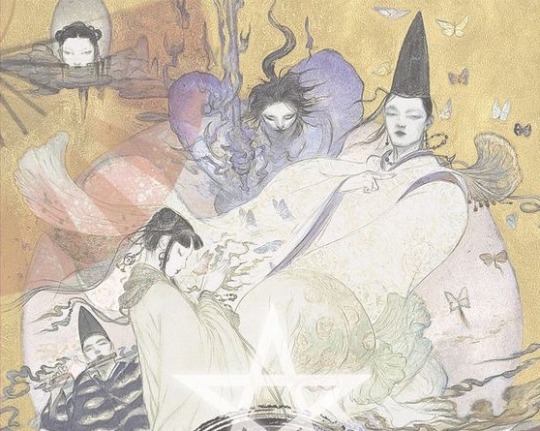
Yoshitaka Amano's illustration of Baku Yumemakura's fictionalized portrayal of Abe no Seimei (right) and other characters from his novels (reproduced here for educational purposes only)
Of course, it’s also impossible to talk about onmyōdō without mentioning the modern “onmyōdō boom”. Starting with the 1980s, onmyōdō once again became a relatively popular topic among writers. Novel series such as Baku Yumemakura’s Onmyōji, Hiroshi Aramata’s Teito Monogatari or Natsuhiko Kyōgoku’s Kyōgōkudō and their adaptations in other media once again popularized it among general audiences. Of course, since these are fantasy or mystery novels, their historical accuracy tends to vary (Yumemakura in particular is reasonably faithful to historical literature, though). Still, they have a lasting impact which would be impossible to accomplish with scholarship alone.
Shikigami: historical truth, historical fiction, or both?
You might have noticed that despite promising a history of shikigami, I haven’t used this term even once through the entire crash course in history of onmyōdō. This was a conscious choice. Shikigami do not appear in any onmyōdō texts, even though they are a mainstay of texts about onmyōdō, and especially of modern literature involving onmyōji.
It would be unfair to say shikigami and their prominence are merely a modern misconception, though. Virtually all of the famous legends about onmyōji feature shikigami, starting with the earliest examples from the eleventh century. Based on Konjaku Monogatari, there evidently was a fascination with shikigami at the time of its compilation. Fujiwara no Akihira in the Shinsarugakuki treats the control of shikigami as an essential skill of an onmyōji, alongside the abilities to “freely summon the twelve guardian deities, call thirty-six types of wild birds (...), create spells and talismans, open and close the eyes of kijin (鬼神; “demon gods”), and manipulate human souls”.
It is generally agreed that such accounts, even though they belong to the realm of literary fiction, can shed light on the nature and importance of shikigami. They ultimately reflect their historical context to some degree. Furthermore, it is not impossible that popular understanding of shikigami based on literary texts influenced genuine onmyōdō tradition. It’s worth pointing out that today legends about Abe no Seimei involving them are disseminated by two contemporary shrines dedicated to him, the Seimei Shrine (晴明神社) in Kyoto and the Abe no Seimei Shrine (安倍晴明神社) in Osaka. Interconnected networks of exchange between literature and religious practice are hardly a unique or modern phenomenon.
However, even with possible evidence from historical literature taken into account, it is not easy to define shikigami. The word itself can be written in three different ways: 式神 (or just 式), 識神 and 職神, with the first being the default option. The descriptions are even more varied, which understandably lead to the rise of numerous interpretations in modern scholarship. Carolyn Pang in her recent treatments of shikigami, which you can find in the bibliography, has recently divided them into five categories. I will follow her classification below.
Shikigami take 1: rikujin-shikisen
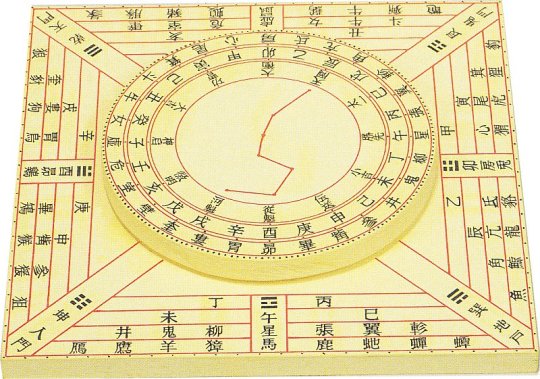
An example of shikiban, the divination board used in rikujin-shikisen (Museum of Kyoto, via onmarkproductions.com; reproduced here for educational purposes only)
A common view is that shikigami originate as a symbolic representation of the power of shikisen (式占) or more specifically rikujin-shikisen (六壬式占), the most common form of divination in onmyōdō. It developed from Chinese divination methods in the Nara period, and remained in the vogue all the way up to the sixteenth century, when it was replaced by ekisen (易占), a method derived from the Chinese Book of Changes.
Shikisen required a special divination board known as shikiban (式盤), which consists of a square base, the “earth panel” (地盤, jiban), and a rotating circle placed on top of it, the “heaven panel” (天盤, tenban). The former was marked with twelve points representing the signs of the zodiac and the latter with representations of the “twelve guardians of the months” (十二月将, jūni-gatsushō; their identity is not well defined). The heaven panel had to be rotated, and the diviner had to interpret what the resulting combination of symbols represents. Most commonly, it was treated as an indication whether an unusual phenomenon (怪/恠, ke) had positive or negative implications.
It’s worth pointing out that in the middle ages the shikiban also came to be used in some esoteric Buddhist rituals, chiefly these focused on Dakiniten, Shōten and Nyoirin Kannon. However, they were only performed between the late Heian and Muromachi periods, and relatively little is known about them. In most cases the divination board was most likely modified to reference the appropriate esoteric deities.
Shikigami take 2: cognitive abilities
While the view that shikigami represented shikisen is strengthened by the fact both terms share the kanji 式, a variant writing, 識神, lead to the development of another proposal. Since the basic meaning of 識 is “consciousness”, it is sometimes argued that shikigami were originally an “anthropomorphic realization of the active psychological or mental state”, as Caroline Pang put it - essentially, a representation of the will of an onmyōji. Most of the potential evidence in this case comes from Buddhist texts, such as Bosatsushotaikyō (菩薩処胎経).
However, Bernard Faure assumes that the writing 識神 was a secondary reinterpretation, basically a wordplay based on homonymy. He points out the Buddhist sources treat this writing of shikigami as a synonym of kushōjin (倶生神). This term can be literally translated as “deities born at the same time”. Most commonly it designates a pair of minor deities who, as their name indicates, come into existence when a person is born, and then records their deeds through their entire life. Once the time for Enma’s judgment after death comes, they present him with their compiled records. It has been argued that they essentially function like a personification of conscience.
Shikigami take 3: energy
A further speculative interpretation of shikigami in scholarship is that this term was understood as a type of energy present in objects or living beings which onmyōji were believed to be capable of drawing out and harnessing to their ends. This could be an adaptation of the Daoist notion of qi (氣). If this definition is correct, pieces of paper or wooden instruments used in purification ceremonies might be examples of objects utilized to channel shikigami.
The interpretation of shikigami as a form of energy is possibly reflected in Konjaku Monogatari in the tale The Tutelage of Abe no Seimei under Tadayuki. It revolves around Abe no Seimei’s visit to the house of the Buddhist monk Kuwanten from Hirosawa. Another of his guests asks Seimei if he is capable of killing a person with his powers, and if he possesses shikigami. He affirms that this is possible, but makes it clear that it is not an easy task. Since the guests keep urging him to demonstrate nonetheless, he promptly demonstrates it using a blade of grass. Once it falls on a frog, the animal is instantly crushed to death. From the same tale we learn that Seimei’s control over shikigami also let him remotely close the doors and shutters in his house while nobody was inside.
Shikigami take 4: curse
As I already mentioned, arts which can be broadly described as magic - like the already mentioned jujutsu or juhō (呪法, “magic rituals”) - were regarded as a core part of onmyōji’s repertoire from the Heian period onward. On top of that, the unlicensed onmyōji were almost exclusively associated with curses. Therefore, it probably won’t surprise you to learn that yet another theory suggests shikigami is simply a term for spells, curses or both. A possible example can be found in Konjaku Monogatari, in the tale Seimei sealing the young Archivist Minor Captains curse - the eponymous curse, which Seimei overcomes with protective rituals, is described as a shikigami.

Kunisuda Utagawa's illustration of an actor portraying Dōman in a kabuki play (wikimedia commons)
Similarities between certain descriptions of shikigami and practices such as fuko (巫蠱) and goraihō (五雷法) have been pointed out. Both of these originate in China. Fuko is the use of poisonous, venomous or otherwise negatively perceived animals to create curses, typically by putting them in jars, while goraihō is the Japanese version of Daoist spells meant to control supernatural beings, typically ghosts or foxes. It’s worth noting that a legend according to which Dōman cursed Fujiwara no Michinaga on behalf of lord Horikawa (Fujiwara no Akimitsu) involves him placing the curse - which is itself not described in detail - inside a jar.
Mitsuki Ueno notes that in the Kōchi Prefecture the phrase shiki wo utsu, “to strike with a shiki”, is still used to refer to cursing someone. However, shiki does not necessarily refer to shikigami in this context, but rather to a related but distinct concept - more on that later.
Shikigami take 5: supernatural being
While all four definitions I went through have their proponents, yet another option is by far the most common - the notion of shikigami being supernatural beings controlled by an onmyōji. This is essentially the standard understanding of the term today among general audiences. Sometimes attempts are made to identify it with a specific category of supernatural beings, like spirits (精霊, seirei), kijin or lesser deities (下級神, kakyū shin). However, none of these gained universal support. Generally speaking, there is no strong indication that shikigami were necessarily imagined as individualized beings with distinct traits.
The notion of shikigami being supernatural beings is not just a modern interpretation, though, for the sake of clarity. An early example where the term is unambiguously used this way is a tale from Ōkagami in which Seimei sends a nondescript shikigami to gather information. The entity, who is not described in detail, possesses supernatural skills, but simultaneously still needs to open doors and physically travel.
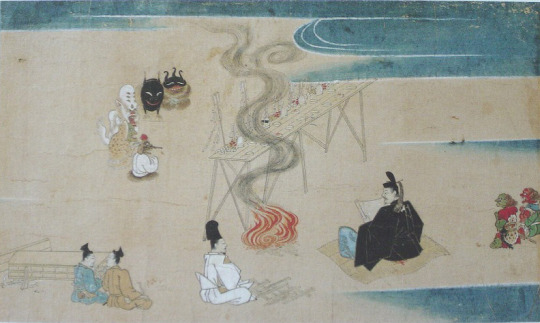
An illustration from Nakifudō Engi Emaki (wikimedia commons)
In Genpei Jōsuiki there is a reference to Seimei’s shikigami having a terrifying appearance which unnerved his wife so much he had to order the entities to hide under a bride instead of residing in his house. Carolyn Pang suggests that this reflects the demon-like depictions from works such as Abe no Seimei-kō Gazō (安倍晴明公画像; you can see it in the Heian section), Fudōriyaku Engi Emaki and Nakifudō Engi Emaki.
Shikigami and related concepts
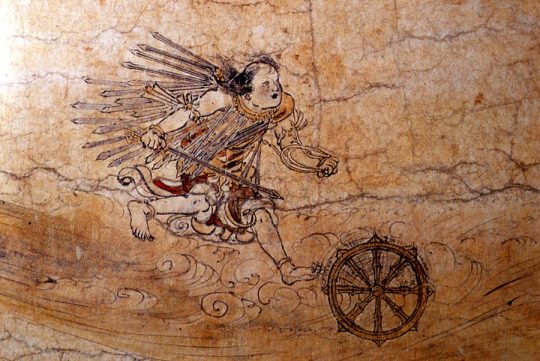
A gohō dōji, as depicted in the Shigisan Engi Emaki (wikimedia commons)
The understanding of shikigami as a “spirit servant” of sorts can be compared with the Buddhist concept of minor protective deities, gohō dōji (護法童子; literally “dharma-protecting lads”). These in turn were just one example of the broad category of gohō (護法), which could be applied to virtually any deity with protective qualities, like the historical Buddha’s defender Vajrapāṇi or the Four Heavenly Kings.
A notable difference between shikigami and gohō is the fact that the former generally required active summoning - through chanting spells and using mudras - while the latter manifested on their own in order to protect the pious. Granted, there are exceptions. There is a well attested legend according to which Abe no Seimei’s shikigami continued to protect his residence on own accord even after he passed away. Shikigami acting on their own are also mentioned in Zoku Kojidan (続古事談). It attributes the political downfall of Minamoto no Takaakira (源高明; 914–98) to his encounter with two shikigami who were left behind after the onmyōji who originally summoned them forgot about them.
A degree of overlap between various classes of supernatural helpers is evident in texts which refer to specific Buddhist figures as shikigami. I already brought up the case of the kushōjin earlier. Another good example is the Tendai monk Kōshū’s (光宗; 1276–1350) description of Oto Gohō (乙護法). He is “a shikigami that follows us like the shadow follows the body. Day or night, he never withdraws; he is the shikigami that protects us” (translation by Bernard Faure). This description is essentially a reversal of the relatively common title “demon who constantly follow beings” (常随魔, jōzuima). It was applied to figures such as Kōjin, Shōten or Matarajin, who were constantly waiting for a chance to obstruct rebirth in a pure land if not placated properly.

The Twelve Heavenly Generals (Tokyo National Museum, via wikimedia commons)
A well attested group of gohō, the Twelve Heavenly Generals (十二神将, jūni shinshō), and especially their leader Konpira (who you might remember from my previous article), could be labeled as shikigami. However, Fujiwara no Akihira’s description of onmyōji skills evidently presents them as two distinct classes of beings.

A kuda-gitsune, as depicted in Shōzan Chomon Kishū by Miyoshi Shōzan (Waseda University History Museum; reproduced here for educational purposes only)
Granted, Akihira also makes it clear that controlling shikigami and animals are two separate skills. Meanwhile, there is evidence that in some cases animal familiars, especially kuda-gitsune used by iizuna (a term referring to shugenja associated with the cult of, nomen omen, Iizuna Gongen, though more broadly also something along the lines of “sorcerer”), were perceived as shikigami.
Beliefs pertaining to gohō dōji and shikigami seemingly merged in Izanagi-ryū, which lead to the rise of the notion of shikiōji (式王子; ōji, literally “prince”, can be another term for gohō dōji). This term refers to supernatural beings summoned by a ritual specialist (祈祷師, kitōshi) using a special formula from doctrinal texts (法文, hōmon). They can fulfill various functions, though most commonly they are invoked to protect a person, to remove supernatural sources of diseases, to counter the influence of another shikiōji or in relation to curses.
Tenkeisei, the god of shikigami
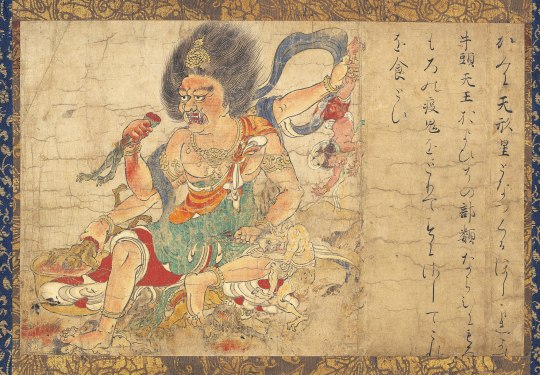
Tenkeisei (wikimedia commons)
The final matter which warrants some discussion is the unusual tradition regarding the origin of shikigami which revolves around a deity associated with this concept.
In the middle ages, a belief that there were exactly eighty four thousand shikigami developed. Their source was the god Tenkeisei (天刑星; also known as Tengyōshō). His name is the Japanese reading of Chinese Tianxingxing. It can be translated as “star of heavenly punishment”. This name fairly accurately explains his character. He was regarded as one of the so-called “baleful stars” (凶星, xiong xing) capable of controlling destiny. The “punishment” his name refers to is his treatment of disease demons (疫鬼, ekiki). However, he could punish humans too if not worshiped properly.
Today Tenkeisei is best known as one of the deities depicted in a series of paintings known as Extermination of Evil, dated to the end of the twelfth century. He has the appearance of a fairly standard multi-armed Buddhist deity. The anonymous painter added a darkly humorous touch by depicting him right as he dips one of the defeated demons in vinegar before eating him. Curiously, his adversaries are said to be Gozu Tennō and his retinue in the accompanying text. This, as you will quickly learn, is a rather unusual portrayal of the relationship between these two deities.
I’m actually not aware of any other depictions of Tenkeisei than the painting you can see above. Katja Triplett notes that onmyōdō rituals associated with him were likely surrounded by an aura of secrecy, and as a result most depictions of him were likely lost or destroyed. At the same time, it seems Tenkeisei enjoyed considerable popularity through the Kamakura period. This is not actually paradoxical when you take the historical context into account: as I outlined in my recent Amaterasu article, certain categories of knowledge were labeled as secret not to make their dissemination forbidden, but to imbue them with more meaning and value.
Numerous talismans inscribed with Tenkeisei’s name are known. Furthermore, manuals of rituals focused on him have been discovered. The best known of them, Tenkeisei-hō (天刑星法; “Tenkeisei rituals”), focuses on an abisha (阿尾捨, from Sanskrit āveśa), a ritual involving possession by the invoked deity. According to a legend was transmitted by Kibi no Makibi and Kamo no Yasunori. The historicity of this claim is doubtful, though: the legend has Kamo no Yasunori visit China, which he never did. Most likely mentioning him and Makibi was just a way to provide the text with additional legitimacy.
Other examples of similar Tenkeisei manuals include Tenkeisei Gyōhō (天刑星行法; “Methods of Tenkeisei Practice”) and Tenkeisei Gyōhō Shidai (天刑星行法次第; “Methods of Procedure for the Tenkeisei Practice”). Copies of these texts have been preserved in the Shingon temple Kōzan-ji.
The Hoki Naiden also mentions Tenkeisei. It equates him with Gozu Tennō, and explains both of these names refer to the same deity, Shōki (商貴), respectively in heaven and on earth. While Shōki is an adaptation of the famous Zhong Kui, it needs to be pointed out that here he is described not as a Tang period physician but as an ancient king of Rajgir in India. Furthermore, he is a yaksha, not a human. This fairly unique reinterpretation is also known from the historical treatise Genkō Shakusho.
Post scriptum
The goal of this article was never to define shikigami. In the light of modern scholarship, it’s basically impossible to provide a single definition in the first place. My aim was different: to illustrate that context is vital when it comes to understanding obscure historical terms. Through history, shikigami evidently meant slightly different things to different people, as reflected in literature. However, this meaning was nonetheless consistently rooted in the evolving perception of onmyōdō - and its internal changes. In other words, it reflected a world which was fundamentally alive.
The popular image of Japanese culture and religion is often that of an artificial, unchanging landscape straight from the “age of the gods”, largely invented in the nineteenth century or later to further less than noble goals. The case of shikigami proves it doesn’t need to be, though. The malleable, ever-changing image of shikigami, which remained a subject of popular speculation for centuries before reemerging in a similar role in modern times, proves that the more complex reality isn’t necessarily any less interesting to new audiences.
Bibliography
Bernard Faure, A Religion in Search of a Founder?
Idem, Rage and Ravage (Gods of Medieval Japan vol. 3)
Makoto Hayashi, The Female Christian Yin-Yang Master
Jun’ichi Koike, Onmyōdō and Folkloric Culture: Three Perspectives for the Development of Research
Irene H. Lin, Child Guardian Spirits (Gohō Dōji) in the Medieval Japanese Imaginaire
Yoshifumi Nishioka, Aspects of Shikiban-Based Mikkyō Rituals
Herman Ooms, Yin-Yang's Changing Clientele, 600-800 (note there is n apparent mistake in one of the footnotes, I'm pretty sure the author wanted to write Mesopotamian astronomy originated 4000 years ago, not 4 millenia BCE as he did; the latter date makes little sense)
Carolyn Pang, Spirit Servant: Narratives of Shikigami and Onmyōdō Developments
Idem, Uncovering Shikigami. The Search for the Spirit Servant of Onmyōdō
Shin’ichi Shigeta, Onmyōdō and the Aristocratic Culture of Everyday Life in Heian Japan
Idem, A Portrait of Abe no Seimei
Katja Triplett, Putting a Face on the Pathogen and Its Nemesis. Images of Tenkeisei and Gozutennō, Epidemic-Related Demons and Gods in Medieval Japan
Mitsuki Umeno, The Origins of the Izanagi-ryū Ritual Techniques: On the Basis of the Izanagi saimon
Katsuaki Yamashita, The Characteristics of On'yōdō and Related Texts
117 notes
·
View notes
Photo

Sung Dong-il, son-in-law Go Kyung-pyo, wrote, "I've never contacted you, my daughter is good for you" Suun ('This Week')
#Sung Dong-il#Ko Chang-seok#Ryoo Hye-yeong#Go Kyung-pyo#Kim Sung-kyun#Bayerische Staatsbrauerei Weihenstephan#Baekje#Saskatchewan#Father
1 note
·
View note